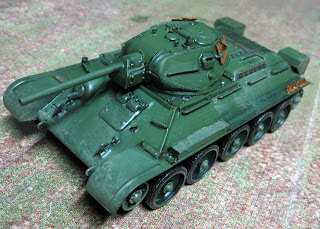Here's the dilemma, I usually paint my models in acrylics, having favored hobby brands as well as artist acrylics. The problem was coming up with the Russian Green. I didn't want to mix it up and find myself far from the intended color and research showed that only Gunze Sangyo lacquers had a Russian Green -- in fact they had 2 -- close to the one I needed. The Gunze Sangyo color codes are C135 Russian Green 1 Flat and C135 Russian Green 2 Flat.
The model was primed with automotive primer and base painted with Tamiya Dark Green. I washed the model with a thin acrylic black and let it dry for a few days.
After finding a local shop that stocked two versions of the Gunze Sangyo Russian Green, I got ready to paint. That is, until I found out that my compressor had gone kaput. The dog and chewed thru some of the cables and lines and I'd have to bring it for repairs. Needless to say, I forged on and decided to brush on the Russian green. Using lacquer as a thinning medium, I applied the color to the model. This was let dry for a day and another wash of black was put on.
After another day, I started drybrushing weathering on the underchassis, the hull and the turrets. I opted to make the spare tank treads a bright rusty orange and lightened up some of the darker shadows made by the black wash. The problem though was that the 2nd wash using enamels must have been mixed with a thinning medium with less spirits. The wash dried shiny! Oh well, I'll just have to get rid of the shine with a final coat of flat varnish after I finish the weathering.
More painting and weathering soon!
The model was primed with automotive primer and base painted with Tamiya Dark Green. I washed the model with a thin acrylic black and let it dry for a few days.
After finding a local shop that stocked two versions of the Gunze Sangyo Russian Green, I got ready to paint. That is, until I found out that my compressor had gone kaput. The dog and chewed thru some of the cables and lines and I'd have to bring it for repairs. Needless to say, I forged on and decided to brush on the Russian green. Using lacquer as a thinning medium, I applied the color to the model. This was let dry for a day and another wash of black was put on.
After another day, I started drybrushing weathering on the underchassis, the hull and the turrets. I opted to make the spare tank treads a bright rusty orange and lightened up some of the darker shadows made by the black wash. The problem though was that the 2nd wash using enamels must have been mixed with a thinning medium with less spirits. The wash dried shiny! Oh well, I'll just have to get rid of the shine with a final coat of flat varnish after I finish the weathering.
More painting and weathering soon!







Comments
Post a Comment